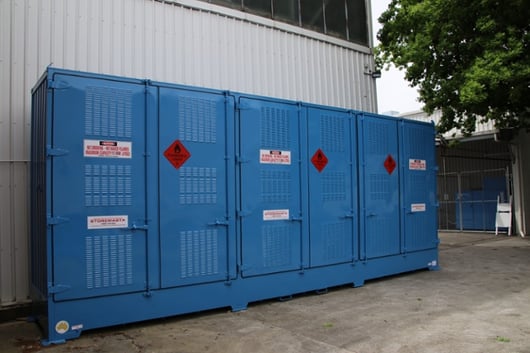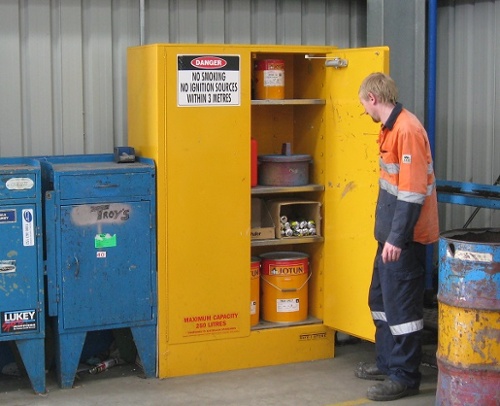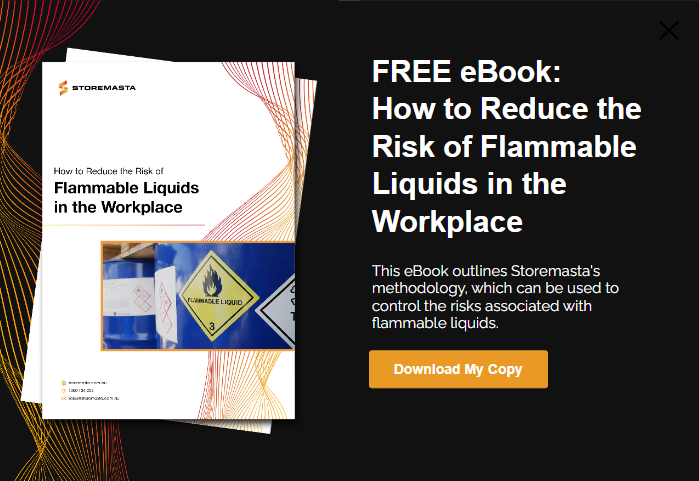For businesses powered by their equipment or their fleet, engine oil is an essential product that may be stored in bulk onsite. Whether you’ve got just a few drums in your workshop or you’re carrying thousands of litres, engine oils must be stored in a way that reduces your risk. To ensure the safe storage of motor oil, you must first understand the chemical properties of the substance. This blog highlights the chemical properties of engine oil and answers the commonly asked question, ‘Is oil flammable’. We’ll also give you tips on how to store oil safely in both outdoor and indoor locations.
What Is Engine Oil?
Engine oils are viscous petrochemicals that have been derived from the fractional distillation of crude oil. As you’re probably aware, oils are immiscible with water — which means that the two liquids won’t mix.
Crude oil is formed deep underground from the decomposition of organic organisms such as algae. After millions of years of geological heat and pressure, the organic matter transforms into oil and gas.
How Are Engine Oils Classed?
To determine if a substance is flammable, you must define the flash point of the liquid. The flash point is the lowest temperature that the liquid releases enough vapours to ignite in the presence of an ignition source.
Engine oils normally have a flash point greater than 150 °C. This means that they’re not a Class 3 Flammable Liquid, as flammable liquids must have a flash point below 60 °C. Therefore, engine oils are classed as combustible liquids.
For the purposes of the Australian Standard AS 1940:2017, combustible liquids are then further classed into 2 categories:
- Class C1 combustible liquids - a closed cup flashpoint of greater than 60°C and no greater than 93°C.
- Class C2 combustible liquids - a flash point exceeding 93°C or has been excluded from being a flammable liquid by any of the criteria for sustaining combustion.
Substances, such as engine oil, that have a flash point above 150 °C are classified as C2 combustible liquids.
Why Are Oils Less Volatile Than Flammable Liquids?
When flammable liquids burn, it’s not the liquid that burns, but the flammable vapour that is dispersed from the flammable liquid. The more easily a liquid gives of flammable vapours, the more easily it will ignite in the presence of an ignition source.
Flammable liquids that give off a lot of flammable vapours are those that are made up of relatively small molecules. Smaller molecules have weaker intermolecular forces of attraction between the molecules. These types of substances require less heat energy to break the bonds between the liquid molecules (causing them to escape as flammable vapour).
Compared with flammable liquids, oils are made up of heavier hydrocarbons that have around 18-34 carbon atoms per molecule. The intermolecular forces of attraction between the molecules are a lot stronger than the forces of attraction that would exist between the small molecules that make up liquids such as petrol.

Oils are regarded as a less volatile substance than flammable liquids due to their flash point of 150 °C, but they are still subject to safe storage requirements.
As the intermolecular forces of attraction are stronger in substances such as engine oil, they will not burn at room temperatures.
A C2 combustible substance would have to be subject to temperatures greater than 150 °C for it to produce enough flammable vapours to ignite in the presence of an ignition source. Therefore, due to these chemical properties, oils are less volatile substances than flammable liquids.
How Should You Store Engine Oil?
Even though engine oils are not classified as Class 3 Flammable Liquids, they are still classed as Dangerous Goods. Therefore, engine oils must be stored in a safe, compliant manner. If engine oils are subject to higher temperatures, there is a possibility that they would produce enough flammable vapours to ignite in the presence of an ignition source.
The Australian Standard that outlines the requirements for the storage and handling of combustible liquids is AS 1940:2017 - The storage and handling of flammable and combustible liquids.
This Standard outlines the design requirements for outdoor and indoor combustible liquid storage facilities — as well as the segregation and separation requirements for the positioning of combustible liquids stores.
Outdoor Storage Of Engine Oil
As engine oil is regarded as a combustible liquid, it must be stored as per the requirements of the AS 1940:2017.
The design requirements for outdoor combustible liquids stores includes factors such as:
- Ventilation
- Spill containment
- Dangerous Goods Signage
Ventilation
To keep the concentration of combustible vapours within the store below the workplace exposure standard, combustible liquids storage facilities must have sufficient ventilation — whether it’s natural ventilation or mechanical ventilation.
Mechanical ventilation systems installed on combustible liquids storage facilities must be intrinsically safe. Therefore, natural ventilation systems are a more practical solution and the preferred ventilation option.
A compliant natural ventilation system can be achieved by having two walls of a combustible liquids store open to the outside atmosphere. These openings on the store can be cladded with a wall of fixed louvers.
Spill Containment
To ensure that any potential spills within the combustible liquids storage container are contained in a safe and compliant manner, all combustible liquids storage facilities must have a spill containment sump in the base of the storage facility.
The capacity of the spill containment sump depends on the quantity of oils being stored within the unit. The required spill containment capacities according to AS 1940 are shown below:
Facilities Storing Less Than 10,000L
Spill containment capacity = 100% of the largest package within the store + 25% of the aggregate capacity of the store.
Facilities Storing Between 10,000L - 100,000L
Spill containment capacity = 100% or the largest package within the store + 25% of the aggregate capacity of the store + 10% of storage capacity between 10,000L and 100,000L.
Facilities Storing More Than 100,000L
Spill containment capacity = 100% of the largest package within the store + 25% of the aggregate capacity of the store + 10% of storage capacity between 10,000L and 100,000L + 5% of the storage capacity exceeding 100,000L
Segregation Requirements For Combustible Liquids Storage Facilities
Flammable and combustible liquids are incompatible with some other classes of Dangerous Goods.
If incompatible Dangerous Goods mix, it can result in violent chemical reactions that could harm people and property. To reduce the risk of chemical reactions, flammable and combustible liquids must be segregated from other incompatible classes of Dangerous Goods.
The compatibility of flammable/combustible liquids with other classes of Dangerous Goods is shown on the chart below:
|
Dangerous Goods class |
Segregation required from Class 3 Liquids |
|
Class 2.1 - Flammable Gas |
Segregate |
|
Class 2.2 - Non-flammable, Non-toxic Gas |
Keep Apart |
|
Class 3 - Flammable/Combustible Liquids |
Compatible |
|
Class 4.1 - Flammable Solids |
Keep Apart |
|
Class 4.2 - Spontaneously Combustibles |
Segregate |
|
Class 4.3 - Dangerous When Wet |
Segregate |
|
Class 5.1 - Oxidising Agents |
Segregate |
|
Class 5.2 - Organic Peroxides |
Isolate |
|
Class 6 - Toxic Substances |
Keep Apart |
|
Class 8 - Corrosive Substances |
Keep Apart |
Key:
Keep Apart: Dangerous goods of these Classes should be kept apart by at least 3m. Consult the SDS or supplier
Segregate: These combinations of dangerous goods should be segregated by at least 5m and kept in separate compounds or building compartments.
Isolate: This requirement applies to organic peroxides, for which dedicated stores or storage cabinets are recommended. Adequate separation from other buildings and boundaries is required.
Compatible: Dangerous Goods of the same Class should be compatible; consult SDS or suppliers about requirements for individual substances.
Separation From Ignition Sources and Protected Places
To reduce the risk of harm to people and property, flammable and combustible liquids such as oils must be separated from ignition sources and protected places. Combustible liquids storage facilities must be separated from all ignition sources by a distance of at least 3 metres. Stores of combustible liquids must also be separated from onsite protected places by at least 3 metres.
AS 1940 defines an onsite protected place as:
A building where people are employed within the property boundary, including offices, warehouses, manufacturing or processing areas, amenities and other dangerous goods stores where quantities exceed minor storage.
Indoor Storage Of Engine Oil
AS 1940 outlines different storage requirements for the indoor storage and the outdoor storage of combustible liquids.
Therefore, if you’re storing your engine oil in an indoor location, you should choose a safety cabinet that’s been manufactured in full conformance to AS 1940. This type of safety cabinet is referred to as a flammable liquids storage cabinet or flammable cabinet.

If you’re storing your oil indoors, you must select a safety cabinet that’s been constructed to meet the requirements of AS 1940.
Features of a compliant flammable liquids cabinet include:
- The walls, floor, doors and roof of the flammable cabinet must be constructed from a double walled sheet steel construction. The gap between these walls must be no less than 40mm and can be left empty or filled with a fire-resistant insulation.
- The gaps around the doors and the walls of the flammable storage cabinet shall be sealed to prevent heat radiation and the spread of flames in the event of a fire.
- The base of the cabinet shall form a liquid-tight sump of at least 150mm deep. This sump must be designed in such a way that packages are prevented from being stored in the sump. This sump will contain any spills that may occur inside the cabinet.
- The shelves inside the cabinet must be perforated to allow for free air movement inside the cabinet. The shelves should also be sturdy and capable of carrying the maximum possible load.
- The inside of the cabinet including the shelves shall be designed in such a way that any spills are directed into the sump in the base of the cabinet.
- The doors of the cabinet shall be self-closing, close-fitting and held shut automatically by catches at two or more points.
- If the doors are equipped with a device to hold the doors permanently open when the cabinet is being loaded, the doors must automatically close when the temperature exceeds 80 °C.
- Materials that are critical to the structural integrity of the cabinet must not melt at temperatures below 850 °C. Seals and gaskets are an exemption to this requirement.
How Are You Storing Oil In your Business?
As we’ve discussed in this blog, oils are not classified as Class 3 Flammable Liquids because they don’t emit enough flammable vapours to ignite (in the presence of an ignition source) at temperatures below 60 °C. Even though engine oils aren’t classified as flammable liquids, they must be stored in full conformance to AS 1940 - the storage and handling of flammable and combustible liquids. You can achieve safe storage of your oils by following the requirements in the Australian Standard. You can also learn more about safe chemical storage by accessing our free eBook How To Reduce The Risk Of Flammable Liquids In The Workplace. We’ll also introduce you to our effective 4-step risk control methodology — that you can easily apply to your own workplace. Get your copy of our helpful guide for free today.
Joining the team as a Dangerous Goods Storage Consultant, Melissa Hampton became Storemasta's Marketing Manager in late 2021. With extensive knowledge and experience in chemical compliance, Melissa is responsible for leading the Marketing team and helping shape their marketing strategy. In her spare time, you can find Melissa hiking, swimming and enjoying the great outdoors in beautiful north-west Tasmania.

